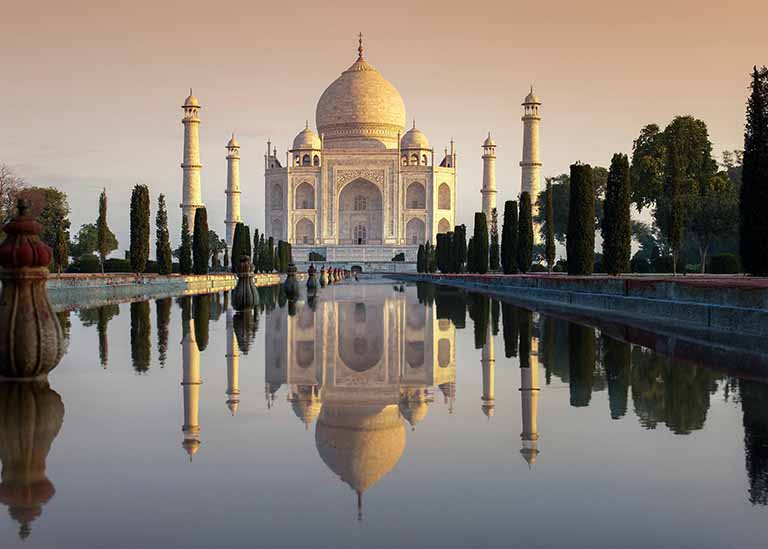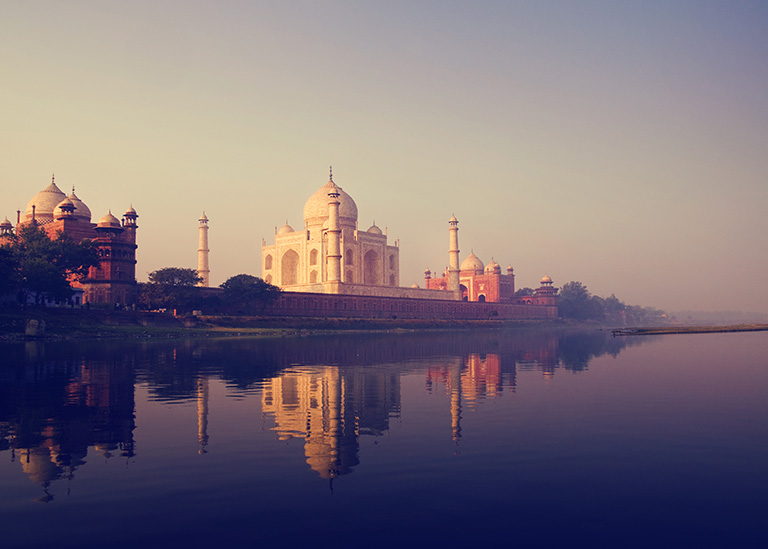Back to Homepage / Blogs / Jul 2024
Love Carved in Marble: The History Behind Taj Mahal
When we think of the Taj Mahal in India, it often evokes a sense of awe and wonder. Its breathtaking architectural design, adorned with intricate marble inlays and meticulously arranged symmetrical gardens, captivates the viewers, making it a timeless beauty. Situated along the tranquil banks of the river Yamuna, this masterpiece stands as a timeless symbol of love and eternal devotion.
Beyond its architectural beauty and grandiose scale, the Taj Mahal also stands as a testament to engineering prowess. The use of innovative construction techniques, such as the intentional leaning of the minarets, showcases the engineers' mastery. The Taj Mahal's minarets were intentionally designed to lean outwards to protect the main structure. In the event of seismic activity, the minarets would fall away from the central structure, thus, reducing the risk of damage to the Taj Mahal's core.
In essence, the Taj Mahal not only embodies awe-inspiring beauty but also serves as a testament to engineering mastery, safeguarding its magnificence from natural forces.

Symmetrical Gardens

The Taj Mahals minarets
Journey Through The Past: The Story Behind Taj Mahal's Construction
Commissioned by Mughal Emperor Shah Jahan in the year 1632, this masterpiece was built as a mausoleum in memory of his beloved wife, Mumtaz Begum. To build this masterpiece, Shah Jahan employed architects, artisans, and engineers who conceptualized and planned the construction of the Taj Mahal. Altogether, it took around 20,000 artisans, craftsmen, and laborer's to build this magnificent structure. These individuals were experts in various fields, including masonry, stone carving, and calligraphy.
The construction of the Taj Mahal involved different artistic techniques blending Persian, Islamic, and Indian architectural styles. It also included sophisticated techniques for marble carving, inlay works, and intricate designs. These artisans carved marble into beautiful designs and patterns, resulting in the creation of a breathtaking monument.
The overall design of the Taj Mahal is drawn from the Persian and Mughal architectural styles, including the arches in the entrance and interior chambers and the grand central dome. The grand central dome, standing over 70 meters high, features intricate calligraphy and decorative elements that include Islamic signs and verses from the Quran, thus, adding a touch of divinity to the monument.
Besides this, the layout of the gardens surrounding the Taj Mahal follows the Persian Charbagh style. In Islam, the Charbagh style refers to a specific layout where the garden is divided into four equal parts by water channels. This is exactly how the gardens of the Taj Mahal are divided. The gardens at the Taj Mahal are divided into four parts by long water channels that intersect at the centre, creating a reflective pool. At the centre of the garden stands the Taj Mahal, whose beauty is mirrored in the reflective pool.
While the Persian architectural style is prominent, the Taj Mahal also had the influence of the Indian architectural style. The Taj Mahal incorporated floral patterns, geometric designs, and ornamental elements from Indian art. Plus, the use of white marble sourced from Rajasthan further exemplifies the fusion of Indian architecture into the construction of the Taj Mahal.

Mughal Emperor Shah Jahan

Mumtaz Begum
What also stands out is the geometry of the Taj Mahal. The entire structure, including the gardens, main mausoleum, and other structures, are perfectly aligned along the central axis. This arrangement, from the gardens to the main mausoleum, symbolizes an impeccable sense of harmony and equilibrium.
In addition to this, some elements of the exteriors of the Taj Mahal adhere to the mathematical principle, like the golden ratio. The golden ratio, also known as the golden mean, is a mathematical ratio of 1.618:1. It is a proportion considered to be aesthetically pleasing and is applied in arts and architecture. It is believed that the Taj Mahal's dimensions and proportions adhere closely to the golden ratio, contributing to the aesthetic appeal of the monument.
The geometric symmetry is not limited to only a few exterior elements. The gardens surrounding the monument are also laid out in precise geometric symmetry. The quadrilateral design of the monument, divided into four parts by long waterways, adds geometric elegance to the Taj Mahal.
The geometry precision extends beyond the exteriors of the Taj Mahal. The interior of the Taj Mahal has a similar geometric precision that is found in the exteriors. The central chamber in the Taj Mahal is in an octagonal shape. This octagonal layout creates a visually balanced and harmonious space, thereby enhancing the aesthetic appeal of the central chamber. The main chamber houses cenotaphs of Shah Jahan and Mumtaz Begum, positioned at the centre of the room.
Even the marble surfaces have intricate geometric designs and patterns. The designs include floral motifs, arabesques, and inscriptions from the holy Quran, adding aesthetic intricacy and spiritual depth to the interior ambience, creating a divine space within the Taj Mahal. That's not all. The jalis, ornamental screens carved from marble, feature delicate geometrical patterns, which allow light to filter through the screens, casting beautiful shadow patterns across the chamber.
Every detail within the Taj Mahal's interiors and exteriors, from the geometrical patterns of the gardens to the interior designs, showcases an exquisite testament to precision and masterful execution of geometrical principles. Its geometric symmetry enhances the monument's beauty and creates an awe-inspiring experience for the visitors.

The grand central dome

Taj Mahal in the reflective pool
Symbolism and Belief
Beyond its architectural splendour and historical significance, the Taj Mahal is steeped in symbolism and belief. At its core, the Taj Mahal stands for eternal love. To understand why it symbolises everlasting love, you need to know the story behind the construction.
Shah Jahan spotted his future wife, Mumtaz Begum, at a bazaar in Agra. Spellbound by her beauty, he was adamant to get married to her. He persuaded Mumtaz for five years and then finally got married to her in 1612. They both shared an extraordinary bond. While giving birth, she died of postpartum complications. Seeing the death of his beloved wife, Shah Jahan was inconsolable. This grief led him to construct the Taj Mahal in the memory of his beloved wife. While constructing the Taj Mahal, Shah Jahan wanted materials that symbolize their eternal love. For that, white marbles were used, which was intricately carved with beautiful designs representing the enduring bond between Shah Jahan and Mumtaz Begum.
The Taj Mahal not only stands for eternal love, but it also holds spiritual significance. The inscriptions on the walls reflect the divine verses of the Quran, giving the monument a divine touch. Besides this, the monument is the resting place for Shah Jahan and Mumtaz Begum, making it a holy site. It also stands as a prime example of cultural harmony. Taj Mahal blends different architectural styles, including Persian and Indian, symbolizing cultural unity.
There is symbolism in its architectural elements too. The central dome has a perfect symmetry, which represents the unison of two souls. The flawless symmetry of the dome reaching toward the heavens evokes the inseparable connection between the two individuals, Shah Jahan and Mumtaz Begum. On the other hand, the four minarets metaphorically represent the connection between the earthly realm and the divine. That's not all. The Charbagh Gardens, divided into four parts, represent the concept of paradise on Earth. According to Islamic teachings, the Charbagh style symbolizes the idea of a heavenly paradise.

Agra Red Fort

Yamuna_River
Taj Mahal's Proximity to the River Yamuna and Its Significance
The Taj Mahal is located near the banks of the Yamuna River. The Yamuna River is a tributary of the River Ganges, which is a sacred river for the Hindus. The Hindus consider the Ganges as a place that purifies the soul. Most Hindus come to the Rover Ganges to disperse the ashes of their beloved because the river is what purifies the soul before it reaches its destination - the sky.
In local lore, people create symbolic connections between the Yamuna River's spiritual attributes and the Taj Mahal, drawing metaphorical associations to purification and spirituality. They metaphorically say that the proximity of the Taj Mahal to the Yamuna River symbolizes the purification of Mumtaz Begum's soul.
Leaving the metaphorical association aside, the Taj Mahal's proximity to the river Yamuna holds some significance. First, proximity to the Yamuna River enhances the beauty of the Taj Mahal. The reflection of the monument on the river adds a captivating dimension to its beauty. It creates a mesmerizing mirroring effect that enhances the Taj Mahal's overall beauty.
Second, the Yamuna River played a significant role in transporting materials during the construction of the Taj Mahal. The river facilitated as a major trade route during the Mughal rule, so it was used for transportation of materials. Heavy materials like marble were transported from the quarries to the construction site using this waterway. Boats were used to transport the materials, making it easy to navigate the waterways and efficiently deliver the supplies to the construction site.
Third, there is an architectural context to the placement of the monument near the Yamuna River. The integration of nature into the structures was a hallmark of the Mughal architecture. Renowned for their appreciation of natural beauty, the Mughals often integrated natural elements into their structures, including water features and gardens. With this ethos, the monument was strategically placed near the Yamuna River, creating a peaceful setting. This also led to the shaping of the Taj Mahal's gardens and reflective pools, in line with the Mughal's tradition of integrating architecture with nature.
The Taj Mahal stands not only as a UNESCO World Heritage site but also as a testament to enduring love, spirituality, and engineering prowess.
Visit the Taj Mahal as part of Pandaw's 6 night Golden Triangle extension which can be added to your Ganges River expedition